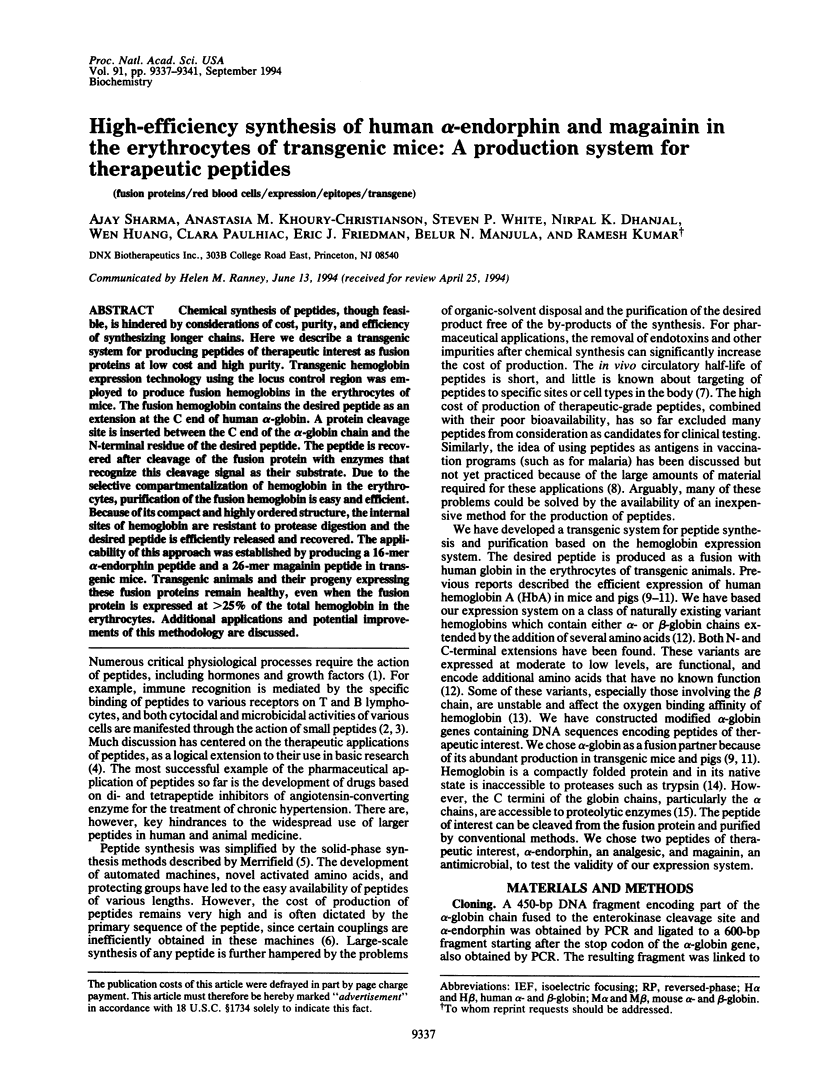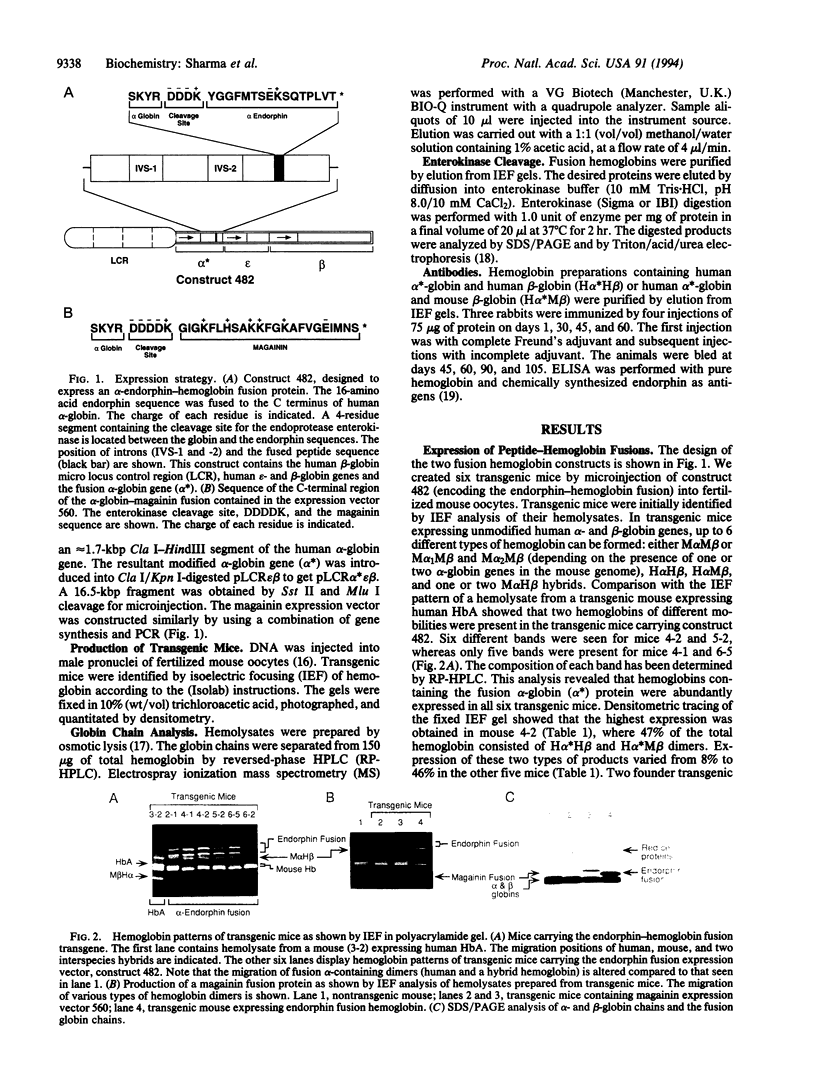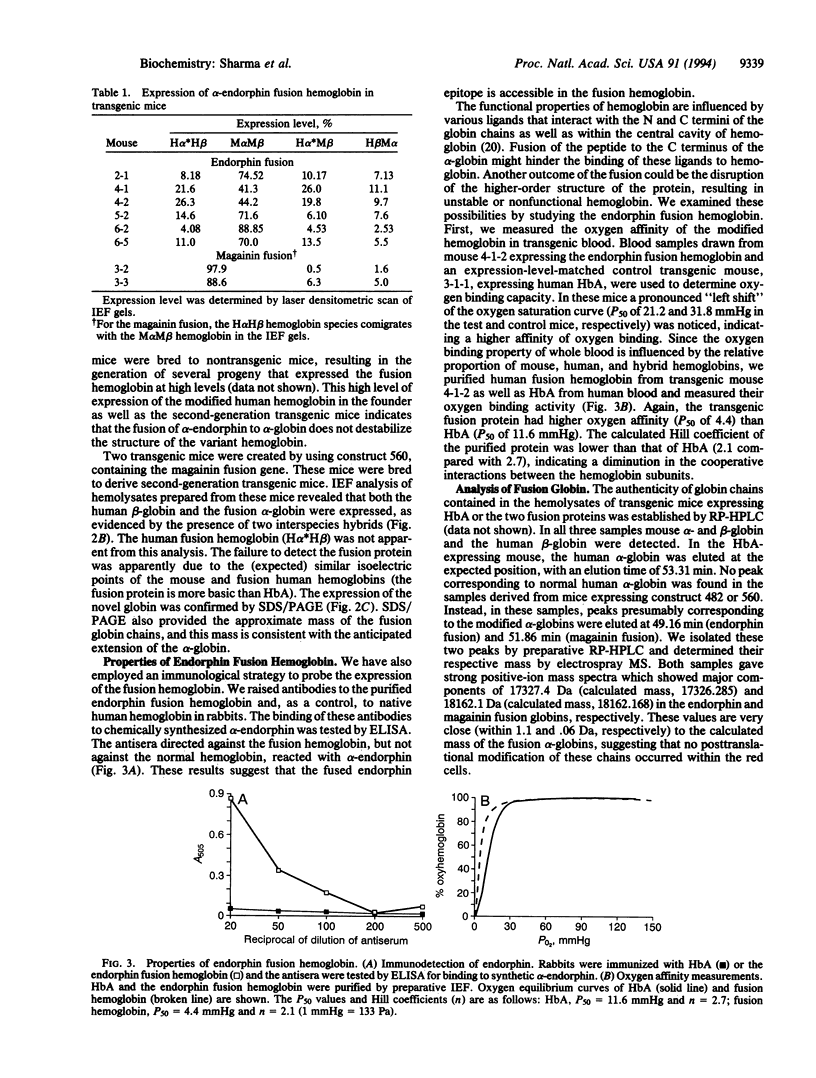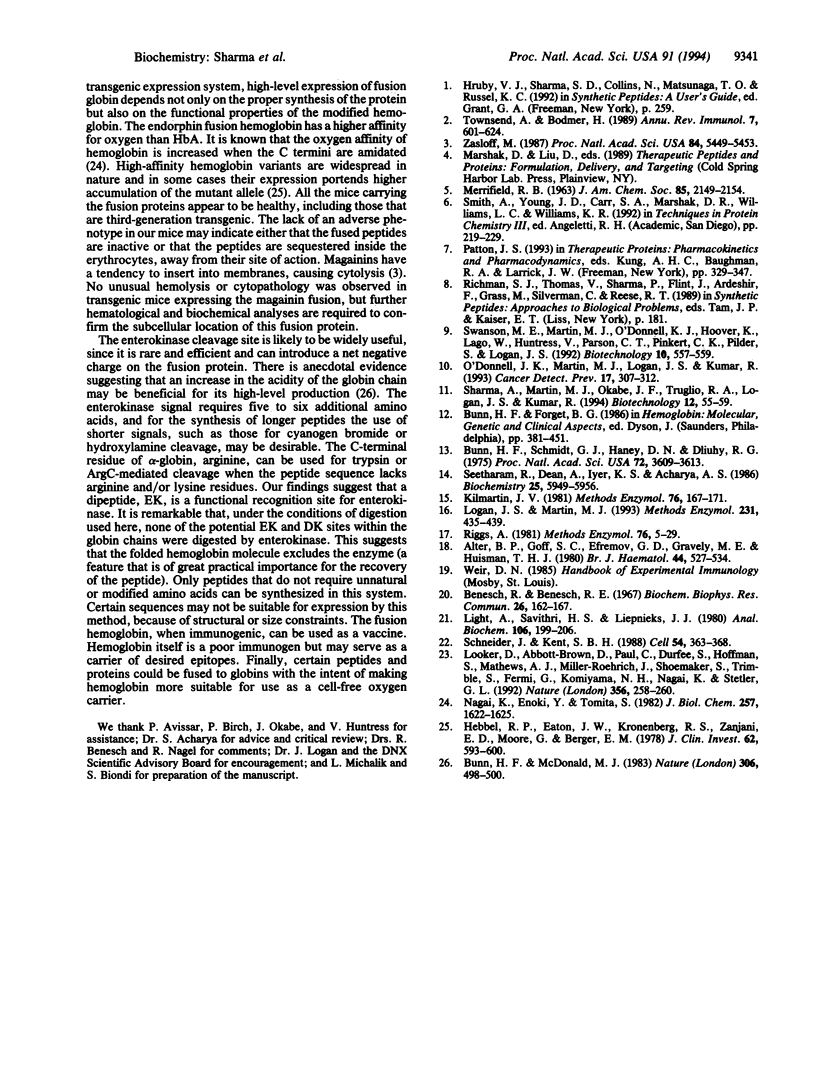Abstract
Chemical synthesis of peptides, though feasible, is hindered by considerations of cost, purity, and efficiency of synthesizing longer chains. Here we describe a transgenic system for producing peptides of therapeutic interest as fusion proteins at low cost and high purity. Transgenic hemoglobin expression technology using the locus control region was employed to produce fusion hemoglobins in the erythrocytes of mice. The fusion hemoglobin contains the desired peptides as an extension at the C end of human alpha-globin. A protein cleavage site is inserted between the C end of the alpha-globin chain and the N-terminal residue of the desired peptide. The peptide is recovered after cleavage of the fusion protein with enzymes that recognize this cleavage signal as their substrate. Due to the selective compartmentalization of hemoglobin in the erythrocytes, purification of the fusion hemoglobin is easy and efficient. Because of its compact and highly ordered structure, the internal sites of hemoglobin are resistant to protease digestion and the desired peptide is efficiently released and recovered. The applicability of this approach was established by producing a 16-mer alpha-endorphin peptide and a 26-mer magainin peptide in transgenic mice. Transgenic animals and their progeny expressing these fusion proteins remain health, even when the fusion protein is expressed at > 25% of the total hemoglobin in the erythrocytes. Additional applications and potential improvements of this methodology are discussed.
Full text
PDF




Images in this article
Selected References
These references are in PubMed. This may not be the complete list of references from this article.
- Alter B. P., Goff S. C., Efremov G. D., Gravely M. E., Huisman T. H. Globin chain electrophoresis: a new approach to the determination of the G gamma/A gamma ratio in fetal haemoglobin and to studies of globin synthesis. Br J Haematol. 1980 Apr;44(4):527–534. doi: 10.1111/j.1365-2141.1980.tb08706.x. [DOI] [PubMed] [Google Scholar]
- Benesch R., Benesch R. E. The effect of organic phosphates from the human erythrocyte on the allosteric properties of hemoglobin. Biochem Biophys Res Commun. 1967 Jan 23;26(2):162–167. doi: 10.1016/0006-291x(67)90228-8. [DOI] [PubMed] [Google Scholar]
- Bunn H. F., McDonald M. J. Electrostatic interactions in the assembly of haemoglobin. Nature. 1983 Dec 1;306(5942):498–500. doi: 10.1038/306498a0. [DOI] [PubMed] [Google Scholar]
- Bunn H. F., Schmidt G. J., Haney D. N., Dluhy R. G. Hemoglobin Cranston, an unstable variant having an elongated beta chain due to nonhomologous crossover between two normal beta chain genes. Proc Natl Acad Sci U S A. 1975 Sep;72(9):3609–3613. doi: 10.1073/pnas.72.9.3609. [DOI] [PMC free article] [PubMed] [Google Scholar]
- Hebbel R. P., Eaton J. W., Kronenberg R. S., Zanjani E. D., Moore L. G., Berger E. M. Human llamas: adaptation to altitude in subjects with high hemoglobin oxygen affinity. J Clin Invest. 1978 Sep;62(3):593–600. doi: 10.1172/JCI109165. [DOI] [PMC free article] [PubMed] [Google Scholar]
- Kilmartin J. V. Removal of specific C-terminal residues from human hemoglobin using carboxypeptidases A and B. Methods Enzymol. 1981;76:167–171. doi: 10.1016/0076-6879(81)76125-1. [DOI] [PubMed] [Google Scholar]
- Light A., Savithri H. S., Liepnieks J. J. Specificity of bovine enterokinase toward protein substrates. Anal Biochem. 1980 Jul 15;106(1):199–206. doi: 10.1016/0003-2697(80)90138-4. [DOI] [PubMed] [Google Scholar]
- Logan J. S., Martin M. J. Transgenic swine as a recombinant production system for human hemoglobin. Methods Enzymol. 1994;231:435–445. doi: 10.1016/0076-6879(94)31029-7. [DOI] [PubMed] [Google Scholar]
- Looker D., Abbott-Brown D., Cozart P., Durfee S., Hoffman S., Mathews A. J., Miller-Roehrich J., Shoemaker S., Trimble S., Fermi G. A human recombinant haemoglobin designed for use as a blood substitute. Nature. 1992 Mar 19;356(6366):258–260. doi: 10.1038/356258a0. [DOI] [PubMed] [Google Scholar]
- Nagai K., Enoki Y., Tomita S., Teshima T. Trypsin-catalyzed synthesis of peptide bond in human hemoglobin. Oxygen binding characteristics of Gly-NH2(142 alpha) Hb. J Biol Chem. 1982 Feb 25;257(4):1622–1625. [PubMed] [Google Scholar]
- O'Donnell J. K., Martin M. J., Logan J. S., Kumar R. Production of human hemoglobin in transgenic swine: an approach to a blood substitute. Cancer Detect Prev. 1993;17(2):307–312. [PubMed] [Google Scholar]
- Riggs A. Preparation of blood hemoglobins of vertebrates. Methods Enzymol. 1981;76:5–29. doi: 10.1016/0076-6879(81)76111-1. [DOI] [PubMed] [Google Scholar]
- Schneider J., Kent S. B. Enzymatic activity of a synthetic 99 residue protein corresponding to the putative HIV-1 protease. Cell. 1988 Jul 29;54(3):363–368. doi: 10.1016/0092-8674(88)90199-7. [DOI] [PubMed] [Google Scholar]
- Seetharam R., Dean A., Iyer K. S., Acharya A. S. Permissible discontinuity region of the alpha-chain of hemoglobin: noncovalent interaction of heme and the complementary fragments alpha 1-30 and alpha 31-141. Biochemistry. 1986 Oct 7;25(20):5949–5955. doi: 10.1021/bi00368a017. [DOI] [PubMed] [Google Scholar]
- Sharma A., Martin M. J., Okabe J. F., Truglio R. A., Dhanjal N. K., Logan J. S., Kumar R. An isologous porcine promoter permits high level expression of human hemoglobin in transgenic swine. Biotechnology (N Y) 1994 Jan;12(1):55–59. doi: 10.1038/nbt0194-55. [DOI] [PubMed] [Google Scholar]
- Swanson M. E., Martin M. J., O'Donnell J. K., Hoover K., Lago W., Huntress V., Parsons C. T., Pinkert C. A., Pilder S., Logan J. S. Production of functional human hemoglobin in transgenic swine. Biotechnology (N Y) 1992 May;10(5):557–559. doi: 10.1038/nbt0592-557. [DOI] [PubMed] [Google Scholar]
- Townsend A., Bodmer H. Antigen recognition by class I-restricted T lymphocytes. Annu Rev Immunol. 1989;7:601–624. doi: 10.1146/annurev.iy.07.040189.003125. [DOI] [PubMed] [Google Scholar]
- Zasloff M. Magainins, a class of antimicrobial peptides from Xenopus skin: isolation, characterization of two active forms, and partial cDNA sequence of a precursor. Proc Natl Acad Sci U S A. 1987 Aug;84(15):5449–5453. doi: 10.1073/pnas.84.15.5449. [DOI] [PMC free article] [PubMed] [Google Scholar]




